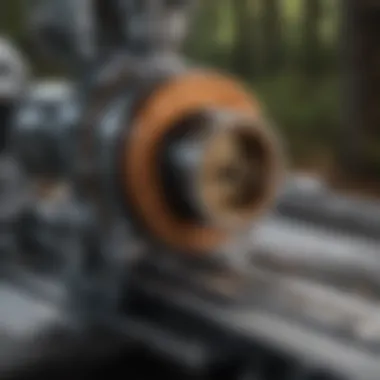Veneer Lathe: Exploring Functionality and Innovation


Intro
The veneer lathe is a significant tool in the woodworking industry, allowing for the production of thin slices of wood from logs. This article aims to shed light on the intricate functionality and varied applications of the veneer lathe, as well as recent innovations that have enhanced its use. By understanding the mechanics of this tool, professionals in woodworking can appreciate its importance in crafting fine furniture and veneers. Additionally, the article will explore how advancements in veneer lathe technology relate to sustainable forestry practices, thus linking woodworking with environmental stewardship.
Understanding Woodland Ecosystems
Woodland ecosystems are vital to our planet. These systems support a diverse range of species and play a crucial role in the balance of our environment.
Importance of Biodiversity in Forests
Biodiversity is a measure of the variety of life within an ecosystem. Forests with high biodiversity tend to be more resilient and productive. The presence of numerous species means a balanced ecosystem, which can recover from disturbances, such as pests or diseases. Furthermore, biodiversity contributes to the aesthetic and cultural value of forests, making them valuable to communities.
Role of Forests in Climate Regulation
Forests act as carbon sinks. They sequester carbon dioxide from the atmosphere and store it in their biomass. This process is essential for mitigating climate change. Through photosynthesis, forests also produce oxygen and regulate temperature. Healthy forest ecosystems are vital for maintaining climatic stability and support life on Earth.
Sustainable Forestry Practices
Sustainable forestry is a proactive approach that aims to manage forests in a way that meets current needs without compromising future generations.
Principles of Sustainable Forestry
There are several key principles of sustainable forestry:
- Maintaining Forest Health: Managing for biodiversity and ecosystem health ensures forests can thrive.
- Responsible Harvesting: Practicing selective cutting reduces impact on the ecosystem.
- Restoration and Replanting: Ensuring that felled areas are replanted contributes to forest regeneration.
Case Studies of Successful Implementations
In Sweden, the forest industry has adopted methods that balance economic output with ecosystem health. Techniques such as continuous cover forestry allow forests to be managed for timber production while maintaining biodiversity. This balance is illustrative of sustainable management practices allowing wood resources to be utilized responsibly.
Woodland Stewardship Techniques
Effective woodland stewardship is crucial in safeguarding our ecological heritage. This encompasses a range of practices aimed at maintaining forest vitality.
Forest Management Plans
Developing comprehensive forest management plans is essential. These plans involve mapping out resource utilization, conservation objectives, and economic goals. A well-structured plan leads to better monitoring and more sustainable usage of forest resources.
Conservation Strategies
Conservation strategies are imperative for protecting threatened habitats within forests. This can include creating protected areas or enforcing regulations against illegal logging. By focusing on both the protection and sustainable use of resources, we can ensure that forests are preserved for future generations.
"Forestry is more than just timber production; it is an intricate balance between utilization and stewardship."
By understanding and implementing these practices, professionals in woodworking can contribute positively to the environment while also optimizing the use of tools like the veneer lathe. The interconnection between sustainable forestry and wood production is pivotal for supporting both economic and environmental goals.
Preamble to Veneer Lathes
The veneer lathe serves as a vital tool in woodworking, enabling craftsmen to produce thin sheets of wood for a variety of applications. Understanding its functionality and significance can enhance the woodworking process considerably. This section aims to break down the core elements of veneer lathes, shedding light on their definitions and historical evolution. By grasping these fundamentals, professionals in the forestry and woodworking domains can better appreciate the tool's place in modern manufacturing and artistry.
Definition and Purpose
A veneer lathe is designed specifically for slicing wood into thin sheets, called veneers. These veneers often range in thickness from 0.5 mm to 5 mm. The main purpose of a veneer lathe is to maximize the usable material from a log while minimizing waste. This efficiency makes it essential for various industries, including furniture making, architectural design, and decorative arts. Unlike traditional lathes, which primarily shape wood, veneer lathes focus on producing flat sheets, allowing for a variety of finishes and applications.
History of Veneer Lathes


The history of veneer lathes can be traced back to the early 19th century when the demand for decorative wood surfaces began to rise. Initially, craftsmen relied on manual tools and techniques, which were labor-intensive and time-consuming. The advent of mechanized veneer lathes revolutionized the process by introducing powered machinery, significantly increasing production rates. Over the years, advancements in technology have led to the development of automated and CNC veneer lathes, enabling precision and consistency in veneer production. This evolution reflects broader trends in woodworking, where efficiency and sustainability are increasingly prioritized.
Understanding both the definition and historical context equips craftsmen with a richer view of veneer lathes. This foundational knowledge is crucial for appreciating not only their role in current practices but also their potential for innovation in woodworking.
Core Components of a Veneer Lathe
Understanding the core components of a veneer lathe is essential for grasping how this intricate tool functions. Each part, from the basic structure to the cutting mechanisms and feeding systems, plays a vital role in the efficiency and accuracy of veneer production. Knowing these aspects can significantly enhance one’s appreciation of woodworking processes and enable better decision-making in equipment selection and usage.
Basic Structure and Design
The basic structure of a veneer lathe consists of a sturdy frame designed to withstand the forces generated during operation. This frame is typically constructed from high-quality steel or cast iron, providing stability and durability. Such materials ensure that the lathe can handle the rugged demands of veneer production without suffering from warping or flexing.
At the center of the design is a spindle that holds the wood log securely in place. The axis of the spindle is critical as it allows the log to rotate while being cut. Additionally, the arrangement of the bed and tailstock aids in maintaining alignment during operations. This structural integrity allows for cleaner cuts, which is crucial in producing thin veneer sheets that are usually between 0.5mm to 3mm thick.
Cutting Mechanisms
Cutting mechanisms in a veneer lathe represent one of the most critical core components. They determine the quality and precision of the cut veneer sheets. Traditional veneer lathes rely on a circular knife that rotates while the log is fed into it. The knife’s sharpness and angle are vital; they must be maintained regularly to ensure smooth cutting and minimize tear-out.
Modern advancements have introduced various specialized knives that can produce different grain patterns and finishes. Some lathes have automatic feed systems that work in conjunction with the cutting mechanisms, allowing for continuous operation without manual intervention. This is particularly beneficial in industrial settings where high output is essential.
In summary, the cutting mechanism significantly impacts the final product, and the choice of knives and their maintenance is fundamental for optimal performance.
Feeding Systems
The feeding system of a veneer lathe is responsible for controlling the wood log's entry into the cutting area. An effective feeding mechanism allows for consistent and smooth movement, which directly affects the thickness and quality of the veneer produced.
There are mainly two types of feeding systems: manual and automatic. Manual feeding requires an operator to push the wood log into the cutting edge, making it less suitable for high-volume production. On the other hand, automated feeding systems utilize rollers and motors to advance the log into the cutting area without human intervention. This automation increases efficiency and reduces labor costs, aligning with modern hardwood production needs.
In addition to speed, the precision of the feeding system influences the accuracy of veneer thickness. A small misalignment can lead to uneven cuts and wastage of materials.
Overall, each of these core components—structure, cutting mechanisms, and feeding systems—contributes to the functionality of a veneer lathe. Understanding their roles allows professionals to make informed choices and optimize their woodworking processes.
Operational Principles
Understanding the operational principles of a veneer lathe is vital for anyone working in woodworking and related fields. This section lays the foundation for grasping how these machines function, which in turn influences both efficiency and safety within the workspace. The mechanics behind veneer lathes shape their ability to produce quality veneer, contributing to effective wood utilization and promoting sustainability.
How a Veneer Lathe Operates
A veneer lathe operates on a straightforward but precise principle. The primary function is to rotate a log against a sharp blade. This action allows thin slices of wood, or veneer, to be cut from the log's surface. The log is securely held in place while the blade moves along its length, producing continuous sheets of veneer. Modern lathes often incorporate feeding systems that maintain even pressure, enabling consistent thickness across the veneer sheets.
Here is a breakdown of key operational elements:
- Log Preparation: It’s critical to begin with well-prepared logs. Removing imperfections ensures better quality veneer.
- Rotation and Cutting Mechanism: The mechanism must control the rotation speed and depth of the cut. Proper adjustments impact the efficiency of the process.
- Feeding Systems: These systems can vary in sophistication. Some lathes have manual controls, while others use advanced automated methods that improve efficiency.
The operational setup determines the type and quality of veneer produced, impacting industries from furniture manufacturing to high-end architectural applications. Understanding these principles is not just about mechanics; it also relates to the quality of the finished product and resource management.
Safety Considerations
Safety in operating a veneer lathe cannot be overstated. The machinery involves sharp cutting edges and moving parts, which pose potential hazards. Thus, adhering to safety measures is crucial.
"Safety is not just a preference; it is a necessity in woodworking endeavors."
Consider the following safety practices:
- Personal Protective Equipment (PPE): Always wear appropriate PPE, including goggles, gloves, and ear protection.
- Machine Inspection: Regular inspections should be conducted to ensure all components function correctly. Any defects should be addressed immediately.
- Training and Procedures: Operators should receive thorough training on machine handling and emergency procedures. This preparation minimizes the risk of accidents.
- Emergency Stops: Familiarize yourself with the location and function of emergency stop buttons. Quick access can prevent serious injuries.


Implementing these safety considerations reduces the likelihood of workplace accidents and ensures a more sustainable working environment. It is critical for organizations to prioritize safety protocols to maintain both productivity and worker health.
Types of Veneer Lathes
Understanding the different types of veneer lathes is crucial for any professional or enthusiast in woodworking. Each type caters to specific needs, thus affecting the quality and efficiency of the veneer produced. Knowing these differences can help users make informed decisions based on their production requirements and available resources.
Manual vs. Automated Lathes
Manual veneer lathes have been around for a long time. They require skilled operators who control the cutting process manually. The operator adjusts the speed and feed rate, ensuring that the wood is sliced to the desired thickness. Such models are often less expensive and allow for greater creativity in the crafting process.
However, automation has transformed the woodworking industry. Automated lathes feature advanced controls that can handle complex tasks with high precision. They reduce human error and increase productivity. These machines can operate continuously, making them suitable for large-scale productions.
While both setups have their own merits, the choice often depends on the business size. Smaller workshops may prefer manual lathes for their simplicity and lower costs. In contrast, larger operations might opt for automated models to meet high demands and enhance efficiency.
Specialized vs. General-Purpose Models
The distinction between specialized and general-purpose veneer lathes is significant. Specialized models are designed for specific tasks, such as creating particular veneer thicknesses or handling unique wood types. These machines can include custom features that optimize their performance for specific requirements. For instance, a specialized lathe may have tooling attachments that enhance its capability to process hardwoods more effectively.
On the other hand, general-purpose models offer versatility. They can accommodate various wood types and thicknesses without requiring extensive modifications. While they may lack some of the specialized features, their ability to handle multiple tasks makes them ideal for smaller workshops or businesses that deal with a range of projects.
Applications of Veneer Lathes
Veneer lathes play a crucial role in several industries due to their precision and versatility. Understanding their applications provides insight into how they can be leveraged for various woodworking tasks. These lathes are not just machines; they are essential tools that facilitate intricate work that might otherwise be impossible or inefficient. The applications of veneer lathes can be classified into three primary areas: furniture manufacturing, architectural applications, and artisan woodworking. Each area has unique requirements and benefits that enhance the overall efficiency and creativity in woodworking.
Furniture Manufacturing
In the realm of furniture manufacturing, veneer lathes are indispensable. They allow for the production of thin wood sheets that are used to cover less expensive materials, thus providing an elegant appearance without the high costs associated with solid wood. This process not only maximizes material usage but also reduces waste, a key consideration in today’s environmentally-conscious market.
The benefits of veneer in furniture include aesthetic appeal, lightweight structures, and resistance to warping compared to solid woods. Manufacturers can create various finishes and designs with veneers, allowing for more creativity in product development. This adaptability makes veneer lathes a preferred choice among furniture makers. They can produce customized designs while maintaining uniformity in thickness, which is vital for achieving quality.
Architectural Applications
Veneer lathes are also extensively utilized in architectural applications. Architects often require specific wood types for interior designs, wall paneling, and ceiling treatments. Veneer lathes enable the production of large panels that can be seamlessly applied to surfaces, enhancing the visual appeal and ensuring a cohesive look throughout a space.
Moreover, the use of veneers in architecture supports sustainable practices. As buildings evolve towards greener standards, the ability to use fast-growing trees for veneer means that the demand for slower-growing species can be reduced. This shift helps in preserving valuable forests while still achieving the desired look and feel of high-quality woods. The versatility and efficiency of veneer lathes thus align perfectly with modern architectural goals of sustainability and aesthetic quality.
Artisan Woodworking
For artisan woodworkers, veneer lathes represent a bridge between traditional craftsmanship and modern techniques. Artisans often seek to create customized pieces that showcase unique designs and craftsmanship. Veneer lathes allow for intricate detail that adds character to individual projects, from decorative inlays to complex multi-layered designs.
Artisan woodworkers can work with a range of wood species, selecting specific grains and colors to enhance their creations. The precision of veneer lathes enables artists to push the boundaries of their designs without sacrificing quality. This specialization in unique craftsmanship fosters a market for custom furniture and decor that stands out in a crowded industry.
Technological Advancements in Veneer Lathes
Technological advancements have significantly shaped the development and use of veneer lathes. The influence of modern technology in woodworking is not merely about creating faster machinery; it involves enhancements that improve precision, versatility, and overall efficiency. Recognized for their role in producing thin wood sheets, veneer lathes have changed with innovations that cater to both industrial application and artisan craftsmanship. As the demand for quality veneer increases, so does the necessity for machines that can streamline production while maintaining high standards.
Automation and Efficiency
Automation has revolutionized the veneer industry. Automated veneer lathes now dominate the market because they increase production speeds and reduce human error. These lathes come equipped with sophisticated controls that allow for accurate adjustments in cutting depth and speed, ensuring consistent results across multiple runs. This technical shift has led to several benefits:
- Reduced Labor Costs: With machines performing tasks previously done by hand, operators can focus on higher-level tasks.
- Consistent Quality: Automation reduces variability. Each sheet produced maintains uniformity which is crucial in applications like furniture and architectural elements.
- Scalability: Automated systems can be scaled easily to meet changing demand without a significant increase in workforce.
Moreover, the integration of computer numerical control (CNC) technology further enhances efficiency. By programming intricate cutting patterns into the machine, operators can produce complex designs with minimal manual input.
Smart Technologies


The connection of smart technologies to veneer lathes marks another leap forward. Lathes now utilize sensors and IoT (Internet of Things) capabilities to monitor their operations in real time. This integration provides the following advantages:
- Predictive Maintenance: Sensors within the machine can detect wear and tear before they lead to failures. This proactive approach extends the machine's lifespan and reduces downtime.
- Data Analytics: By collecting operational data, manufacturers can analyze production patterns. This information can lead to better resource allocation and improved production processes.
- Remote Monitoring: Operators can oversee the veneer lathes from a distance, spotting issues or making adjustments without being physically present, increasing flexibility.
"The merging of smart technology with traditional woodworking has transformed how artisans approach their craft."
Environmental Considerations
The role of veneer lathes in woodworking is not only about functionality and efficiency; it also carries significant environmental implications. In an era where sustainability is prioritized, it is crucial to recognize how veneer production can either contribute to or mitigate environmental challenges. This section discusses the sustainable sourcing of wood and the impact on forest ecosystems, highlighting the relevance of eco-friendly practices in modern woodworking.
Sustainable Sourcing of Wood
Sustainable sourcing of wood is an essential element in the veneer production process. This practice ensures that the wood used in manufacturing veneer is harvested in a manner that preserves ecological balance. Sustainable forestry requires adherence to specific criteria that aim to minimize environmental impact. This includes reforestation efforts, reduction of deforestation rates, and maintaining biodiversity.
When selecting wood for veneer production, it is important to prioritize timber that comes from responsibly managed forests. Look for certifications such as those from the Forest Stewardship Council (FSC) or the Programme for the Endorsement of Forest Certification (PEFC). These organizations set standards for sustainable forest management, ensuring that wood products are sourced without causing harm to the environment.
Moreover, using by-products from other industries can also play a vital role in promoting sustainability. Many veneer manufacturers are starting to use less conventional wood species, which might not have been utilized earlier. This not only helps in preserving popular trees from overharvesting but also fosters the use of inherently sustainable practices in the industry.
Impact on Forest Ecosystems
The impact of veneer lathes on forest ecosystems can be profound. When wood is sourced unsustainably, it can lead to degradation of natural habitats, loss of biodiversity, and disruption of local climate patterns. Wood production and processing activities influence various factors such as soil health, water quality, and the overall health of forest ecosystems.
Veneer production that prioritizes sustainable practices can alleviate some of these concerns. By implementing responsible harvesting techniques, manufacturers can ensure that the forest dynamics remain intact. This means allowing animal and plant species to thrive, maintaining soil integrity, and ensuring that waterways are free from pollutants.
Moreover, by actively participating in conservation efforts, companies can have a positive influence on surrounding environments. Collaborations with environmental organizations and advocacy for reforestation serve not only to protect forest ecosystems but also enhance the image of the veneer industry as a whole.
"Sustainable practices in veneer production do not solely benefit the environment; they also create a better image and credibility for manufacturers within the industry."
In summary, the environmental considerations surrounding veneer lathes reflect a growing consciousness about sustainability. The wood sourcing practices and their effects on forest ecosystems are paramount topics that shape the future of this industry. Through responsible practices, veneer lathes can play a significant role in promoting ecological preservation while still meeting the needs of woodworking professionals and enthusiasts.
Future of Veneer Lathes
The future of veneer lathes holds promising developments that can redefine the woodworking industry. As technology continues to evolve, these tools are expected to incorporate more advanced features, increasing their efficiency and enhancing the capabilities of woodworkers. The importance of this topic cannot be overstated. Understanding emerging trends and potential challenges allows professionals to adapt strategically, ensuring sustainability and productivity in their operations.
Emerging Trends
Several trends are shaping the future of veneer lathes.
- Increased Automation: Automated veneer lathes are becoming more prevalent. These machines minimize manual labor and enhance precision, allowing for faster production rates and reduced waste. Technology such as conveyor belts and sensors streamline the processing of wood, responding to the needs of mass production in the furniture industry.
- Integration of Smart Technologies: The rise of the Internet of Things (IoT) connects machines for data sharing. Veneer lathes with smart capabilities can analyze performance metrics. This integration leads to predictive maintenance, which significantly reduces downtime and operational costs.
- Focus on Energy Efficiency: Many manufacturers are investing in energy-efficient designs for veneer lathes. These machines consume less electricity, reducing the overall environmental footprint of wood processing. As sustainability becomes a priority, energy-efficient tools are likely to attract more users.
Potential Challenges
While the future looks bright for veneer lathes, there are notable challenges that the industry may face.
- Economic Factors: The cost of advanced veneer lathes can be prohibitive for small-scale woodworkers. These professionals might struggle to invest in new technology without adequate financial support or incentives.
- Skill Gaps: As technology advances, the need for skilled operators increases. There may be a shortage of workers trained to handle modern machinery, which can hinder production efficiency.
- Regulatory Compliance: Stricter environmental regulations may impact how manufacturers source materials and operate their lathes. Adhering to these regulations requires ongoing investment, which could challenge some businesses.
"The evolution of veneer lathes must align with sustainable practices to ensure the longevity of the industry."
End
The conclusion serves as a critical element in this exploration of veneer lathes, synthesizing insights derived from each preceding section. A well-crafted conclusion transcends mere summary; it elevates the topic and reinforces the significance of understanding veneer lathes in contemporary woodworking practices. The benefits of these machines extend beyond their operational utility. They provide a bridge connecting craftsmanship with sustainability, reflecting the need for responsible use of natural resources.
Recap of Key Insights
In the analysis of veneer lathes, several key insights emerge. Firstly, these lathes are pivotal in the production of thin wood slices, essential for applications ranging from furniture manufacturing to architectural design. The historical progression of veneer lathes reveals a continual evolution in design and functionality, showcasing the craftsmanship behind this distinct machinery. Technological advancements, such as automation and smart technologies, not only enhance efficiency but also encourage more sustainable practices within the industry.
Moreover, environmental considerations underline the importance of sustainable wood sourcing. The integration of efficient machinery like veneer lathes plays a paramount role in creating a balance between production and ecological responsibility.
Call to Action for Sustainable Practices
As we reflect on the findings, there’s an evident call to action for all stakeholders involved in woodworking and forestry. Embracing sustainable practices is not merely an ethical choice; it is a necessity for the longevity of both the industry and the environment. Individuals and organizations should prioritize sustainably sourced materials and support companies that adopt eco-friendly manufacturing methods. By advocating for responsible wood procurement and conservation strategies, we can collectively reduce the environmental impact associated with veneer production.
"The future of woodworking lies not only in innovation but also in the respect for nature coexisting with craftsmanship."







